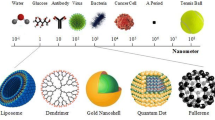Abstract
Health issues induced by mosquito illnesses highlight the need for effective control. Here, we developed an efficient carbon-dot-silver nanohybrid to control Anopheles stephensi and Culex quinquefasciatus mosquito species. The nanohybrid was synthesized using a thermal method without addition of any toxic-reducing agent. Monohybrids are found within the ranges of 2–6 nm for carbon-dot and 10–35 nm for silver nanoparticles with uniform distribution. The uniformly dispersed nanohybrid solutions show excellent larvicidal activity within the concentration range of 0.5–1.0 ppm. Morphological studies evidence the presence of strong bonds between nanohybrid and sulphur- or phosphorus-containing compounds such as proteins and DNA present in the larval body. This explains tissue damage at very low concentrations of nanohybrid. Therefore, this nanoweapon has high potential for field applications.



Similar content being viewed by others
References
Abbott WS (1925) A method of computing the effectiveness of an insecticide. J Ecol Entomol 18:265–266
Afkhami A, Bahiraei A, Mardrakian T (2017) Application of nickel zinc ferrite/graphene nanocomposite as a modifier for fabrication of a sensitive electrochemical sensor for determination of omeprazole in real samples. J Colloid Interface Sci 495:1–8. https://doi.org/10.1016/j.jcis.2017.01.116
Bananezhad A, Ganjali MR, Karimi-Maleh H, Norouzi P (2017) Fabrication of amplified anostructure based sensor for analysis of N-acetylcysteine in presence of high concentration folic acid. Int J Electrochem Sci 12:8045–8058. https://doi.org/10.20964/2017.09.34
Change H, Kang H, Yang JK, Jo A, Lee HY, Jeong DH (2014) Ag shell–Au satellite hetero-nanostructure for ultra-sensitive, reproducible and homogeneous NIRSERS activity. ACS Appl Mater Interfaces 6:11859–11863. https://doi.org/10.1021/am503675x
De B, Karak N (2013) A green and facile approach for the synthesis of water soluble fluorescent carbon dots from banana juice. RSC Adv 3:8286–8290. https://doi.org/10.1039/C3RA00088E
Dsikowitzky L, Dwiyitno Heruwati E, Ariyani F, Irianto HE, Schwarzbauer J (2014) Exceptionally high concentrations of the insect repellent N,N-diethyl-m-toluamide (DEET) in surface waters from Jakarta, Indonesia. Environ Chem Lett 12:407–411. https://doi.org/10.1007/s10311-014-0462-6
Fatope MO, Ibrahim H, Takeda Y (1993) Screening of higher plants reputed as pesticides using the brine shrimp lethality assay. Int J Pharmacogn 31:250–254
Finney JD (1971) Probit analysis: a statistical treatment of the sigmoid response curve. Cambridge University Press, Cambridge, p 256
Jantan B, Yalvema MF, Ahmed NW, Jamal JA (2005) Insecticidal activities of the leaf oils of eight Cinnamomum. species against Aedes aegypti and Aedes albopictus. J Pharm Biol 43:526–532. https://doi.org/10.1080/13880200500220771
Karimi-Maleh HK, Amini F, Akbari A, Shojaei M (2017) Amplified electrochemical sensor employing CuO/SWCNTs and 1-butyl-3-methylimidazolium hexafluorophosphate for selective analysis of sulfisoxazole in the presence of folic acid. J Colloid Interface Sci 495:61–67. https://doi.org/10.1016/j.jcis.2017.01.119
Luo S, Yang ST, Sonkar KS, Wang J, Wang H, LeCroy EG, Cao L, Sun YP (2013) Carbon “quantum” dots for optical bioimaging. J Mater Chem B 1:2116–2127. https://doi.org/10.1039/C3TB00018D
Mukherjee P, Ahmad A, Mandal D, Senapati S, Sainkar SR, Khan MI, Ramani R, Parischa R, Ajayakumar PV, Alam M, Sastry M, Kumar R (2001) Bioreduction of AuCl4 − ions by the fungus, Verticillium sp. and surface trapping of the gold nanoparticles formed. Angew Chem Int Ed Engl 40:3585–3588. https://doi.org/10.1002/1521-3773(20011001)40:19<3585::AID-ANIE3585>3.0.CO;2-K
Muthukumaran U, Govindarajan M, Rajeswary M (2015) Mosquito larvicidal potential of silver nanoparticles synthesized using Chomelia asiatica (Rubiaceae) against Anopheles stephensi, Aedes aegypti and Culex quinquefasciatus (Diptera: Culicidae). Parasitol Res 114:989–999
Roht A, Madhumitha G, Rahman A, Kamaraj C, Bharati C, Surendra TV, Roopan NS (2013) Low-cost and eco-friendly phyto-synthesis of silver nanoparticles using Cocos nucifera coir extract and its larvicidal activity. Ind Crop Prod 43:631–635. https://doi.org/10.1016/j.indcrop.2012.08.013
Somaye C, Mohammad AT, Hassan KM (2017) Highly sensitive square wave voltammetric sensor employing CdO/SWCNTs and room temperature ionic liquid for analysis of vanillin and folic acid in food samples. J Food Compos Anal 62:254–259. https://doi.org/10.1016/j.jfca.2017.06.006
Srinivasan R, Nataranjan D, Karthi S, Shivakumar SM, (2014) Chemical composition and larvicidal activity of Elaeagnus indica Servett (Elaeganaceae) plant leaf extracts against dengue and malaria vectors. Int J Mosq Res 1:66–71. ISSN: 2348-5906
Starowicz M, Stypula B, Banas J (2006) Electrochemical synthesis of silver nanoparticles. Electrochem Commun 8:227–230. https://doi.org/10.1016/j.elecom.2005.11.018
Sukumar K, Perich JM, Boobar RL (1991) Botanical derivatives in mosquito control: a review. J Am Mosq Control Assoc 7:210–237
Tahernejad-Javazmi F, Shabani-Nooshabadi M, Karimi-Maleh H (2018) Analysis of glutathione in the presence of acetaminophen and tyrosine via an amplified electrode with MgO/SWCNTs as a sensor in the hemolyzed erythrocyte. Talanta 176:208–213. https://doi.org/10.1016/j.talanta.2017.08.027
Velayutham K, Ramanibai R (2016) Larvicidal activity of synthesized silver nanoparticles using isoamyl acetate identified in Annona squamosa leaves against Aedes agypti and Culex quinquefasciatus. J Basic Appl Zool 74:16–22. https://doi.org/10.1016/j.jobaz.2016.02.002
Velayutham K, Rahuman AA, Rajakumar G, Roopan SM, Elango G, Kamaraj C, Marimuthu S, Santhoshkumar T, Iyappan M, Siva C (2013) Larvicidal activity of green synthesized silver nanoparticles using bark aqueous extract of Ficus racemosa against Culex quinquefasciatus and Culex gelidus. Asian Pac J Trop Med 6:95–101
Xu X, Ray R, Gu Y, Ploehn HJ, Gearheart L, Raker K, Scrivens WA (2004) Electrophoretic analysis and purification of fluorescent single-walled carbon nanotube fragments. J Am Chem Soc 126:12736–12737. https://doi.org/10.1021/ja040082h
Zhang G, Shen X, Yang Y (2011) Facile synthesis of monodisperse porous ZnO spheres by a soluble starch-assisted method and their photocatalytic activity. J Phys Chem C 115:7145–7152. https://doi.org/10.1021/jp110256s
Acknowledgements
The authors are grateful to DBT, Govt of India, for financial assistance through the Grant BT/518/NE/TBP/2013, and dated 12 December 2014. DRL, Tezpur, and DRDO, New Delhi, are also duly acknowledged for providing the research platform.
Author information
Authors and Affiliations
Corresponding author
Rights and permissions
About this article
Cite this article
Sultana, N., Raul, P.K., Goswami, D. et al. Nanoweapon: control of mosquito breeding using carbon-dot-silver nanohybrid as a biolarvicide. Environ Chem Lett 16, 1017–1023 (2018). https://doi.org/10.1007/s10311-018-0712-0
Received:
Accepted:
Published:
Issue Date:
DOI: https://doi.org/10.1007/s10311-018-0712-0




